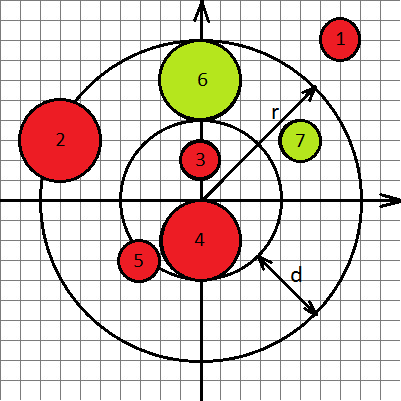Kirill plays a new computer game. He came to the potion store where he can buy any potion. Each potion is characterized by two integers — amount of experience and cost. The efficiency of a potion is the ratio of the amount of experience to the cost. Efficiency may be a non-integer number.
For each two integer numbers a and b such that l ≤ a ≤ r and x ≤ b ≤ y there is a potion with experience a and cost b in the store (that is, there are (r - l + 1)·(y - x + 1) potions).
Kirill wants to buy a potion which has efficiency k. Will he be able to do this?
First string contains five integer numbers l, r, x, y, k (1 ≤ l ≤ r ≤ 107, 1 ≤ x ≤ y ≤ 107, 1 ≤ k ≤ 107).
Print "YES" without quotes if a potion with efficiency exactly k can be bought in the store and "NO" without quotes otherwise.
You can output each of the letters in any register.
1 10 1 10 1
YES
1 5 6 10 1
NO
本来写的是对的,只是没有注意LL
#include<bits/stdc++.h> using namespace std; int main() { ios::sync_with_stdio(false); cin.tie(0); int l,r,x,y,k; cin>>l>>r>>x>>y>>k; for(int i=x;i<=y;i++) if(1LL*i*k>=l&&1LL*i*k<=r) {printf("YES");return 0;} printf("NO"); return 0; }
Gleb ordered pizza home. When the courier delivered the pizza, he was very upset, because several pieces of sausage lay on the crust, and he does not really like the crust.
The pizza is a circle of radius r and center at the origin. Pizza consists of the main part — circle of radius r - d with center at the origin, and crust around the main part of the width d. Pieces of sausage are also circles. The radius of the i -th piece of the sausage is ri, and the center is given as a pair (xi, yi).
Gleb asks you to help determine the number of pieces of sausage caught on the crust. A piece of sausage got on the crust, if it completely lies on the crust.
First string contains two integer numbers r and d (0 ≤ d < r ≤ 500) — the radius of pizza and the width of crust.
Next line contains one integer number n — the number of pieces of sausage (1 ≤ n ≤ 105).
Each of next n lines contains three integer numbers xi, yi and ri ( - 500 ≤ xi, yi ≤ 500, 0 ≤ ri ≤ 500), where xi and yi are coordinates of the center of i-th peace of sausage, ri — radius of i-th peace of sausage.
Output the number of pieces of sausage that lay on the crust.
8 4
7
7 8 1
-7 3 2
0 2 1
0 -2 2
-3 -3 1
0 6 2
5 3 1
2
10 8
4
0 0 9
0 0 10
1 0 1
1 0 2
0

Below is a picture explaining the first example. Circles of green color denote pieces of sausage lying on the crust.
又是一道没有好好读题的题
#include<bits/stdc++.h> using namespace std; int main() { ios::sync_with_stdio(false); cin.tie(0); int d,R; cin>>R>>d; int n; cin>>n; int t=0; while(n--) { int x,y,r; cin>>x>>y>>r; if(x*x+y*y>=(R-d+r)*(R-d+r)&&x*x+y*y<=(R-r)*(R-r)) t++; } cout<<t; return 0; }